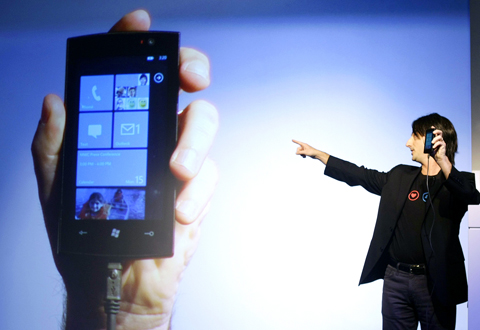Microsoft on Monday unveiled a new version of its mobile operating system as the US software giant seeks to regain lost ground in the highly competitive smartphone market.
Chief executive Steve Ballmer presented the Windows Phone 7 Series at the Mobile World Congress in Barcelona, Spain, ending months of speculation about what Microsoft had in store for the industry’s biggest trade show.
“We’re taking a step, I think a big step,” Ballmer said, adding that devices fitted with the new software would be available in time for the winter holiday shopping season. “I’m enthusiastic about the direction that we’re heading.”

PHOTO: REUTERS
“We hope 7 is our lucky number,” he said.
Microsoft has been up against strong competition from Internet giant Google’s Android, as both newcomers fight for a share of a market dominated by the BlackBerry and Apple’s iPhone.
“The primary goal of Windows Mobile 7 is clearly to address Microsoft’s shortcomings in the consumer mobile market,” said Charles Golvin, analyst at research firm Forrester.
“All plaudits for their persistence aside, in my view this is their final chance to get it right,” Golvin said.
Google has made a splash in the mobile phone industry with its Android operating system, launched in 2007, and phone makers have announced that they would release several more smartphones with this platform this year.
Smartphones fitted with Microsoft’s operating system had 7.9 percent market share in the third quarter of last year, a drop from 11.1 percent in the same period in 2008, research group Gartner said.
In the meantime its rivals grew: BlackBerry maker Research in Motion saw its market share increase to 20.8 percent and Apple’s iPhone rose to 17.1 percent, Gartner said.
Moreover, Android phones took 3.5 percent of the market in just a few months of existence.
“There is no doubt that this phone market is A, highly competitive, B, highly dynamic and C, super exciting,” Ballmer said.
“And there is no question in our minds as we go back a couple of years that we needed ... to do some things that were out of the box, clearly differentiated from our past,” he said.
In its upgrade, Microsoft completely changed the platform’s interface and installed the capabilities of its Zune MP3 player, which has only been available in the US.
The system includes six “hubs” that group services by themes, such as a “people” inbox that includes e-mails, text messages and updates from social network activities, or an Xbox Live icon for online games.
Microsoft-powered touch-screen phones will be rolled out later this year in partnership with several device makers — including Qualcomm, Samsung and LG, as well as operators from AT&T to T-Mobile and Vodafone, the company said.
However, Nicolas Petit, director of Microsoft’s mobile division in France, said the software titan had no intention of following its rivals and creating its own phone.
“It is not in our DNA to build hardware,” he said. “We have partners who do that better than us.”
Google entered the hardware business last month when it launched its own smartphone, Nexus One, in a challenge against another big rival, Apple, which never attends the Mobile World Congress.
In a signal of Google’s ambitions to become a leader in the mobile phone industry, chief executive Eric Schmidt was to address the Barcelona event for the first time yesterday.
Mobile operating systems are the lifeblood of the increasingly popular smartphones, which allows users to surf the Internet, check and send e-mails, play music, videos and games, and take pictures.
Global shipments of smartphones surged 30 percent in the fourth quarter of last year, Strategy Analytics said. By comparison, overall handset sales rose 10 percent in the same period.
In an indication of the growing use of phones with Internet capabilities, the International Telecommunication Union, a UN agency, said on Monday that the number of mobile broadband subscriptions would exceed 1 billion this year after reaching 600 million last year.

IN THE AIR: While most companies said they were committed to North American operations, some added that production and costs would depend on the outcome of a US trade probe Leading local contract electronics makers Wistron Corp (緯創), Quanta Computer Inc (廣達), Inventec Corp (英業達) and Compal Electronics Inc (仁寶) are to maintain their North American expansion plans, despite Washington’s 20 percent tariff on Taiwanese goods. Wistron said it has long maintained a presence in the US, while distributing production across Taiwan, North America, Southeast Asia and Europe. The company is in talks with customers to align capacity with their site preferences, a company official told the Taipei Times by telephone on Friday. The company is still in talks with clients over who would bear the tariff costs, with the outcome pending further

A proposed 100 percent tariff on chip imports announced by US President Donald Trump could shift more of Taiwan’s semiconductor production overseas, a Taiwan Institute of Economic Research (TIER) researcher said yesterday. Trump’s tariff policy will accelerate the global semiconductor industry’s pace to establish roots in the US, leading to higher supply chain costs and ultimately raising prices of consumer electronics and creating uncertainty for future market demand, Arisa Liu (劉佩真) at the institute’s Taiwan Industry Economics Database said in a telephone interview. Trump’s move signals his intention to "restore the glory of the US semiconductor industry," Liu noted, saying that

STILL UNCLEAR: Several aspects of the policy still need to be clarified, such as whether the exemptions would expand to related products, PwC Taiwan warned The TAIEX surged yesterday, led by gains in Taiwan Semiconductor Manufacturing Co (TSMC, 台積電), after US President Donald Trump announced a sweeping 100 percent tariff on imported semiconductors — while exempting companies operating or building plants in the US, which includes TSMC. The benchmark index jumped 556.41 points, or 2.37 percent, to close at 24,003.77, breaching the 24,000-point level and hitting its highest close this year, Taiwan Stock Exchange (TWSE) data showed. TSMC rose NT$55, or 4.89 percent, to close at a record NT$1,180, as the company is already investing heavily in a multibillion-dollar plant in Arizona that led investors to assume

AI: Softbank’s stake increases in Nvidia and TSMC reflect Masayoshi Son’s effort to gain a foothold in key nodes of the AI value chain, from chip design to data infrastructure Softbank Group Corp is building up stakes in Nvidia Corp and Taiwan Semiconductor Manufacturing Co (TSMC, 台積電), the latest reflection of founder Masayoshi Son’s focus on the tools and hardware underpinning artificial intelligence (AI). The Japanese technology investor raised its stake in Nvidia to about US$3 billion by the end of March, up from US$1 billion in the prior quarter, regulatory filings showed. It bought about US$330 million worth of TSMC shares and US$170 million in Oracle Corp, they showed. Softbank’s signature Vision Fund has also monetized almost US$2 billion of public and private assets in the first half of this year,